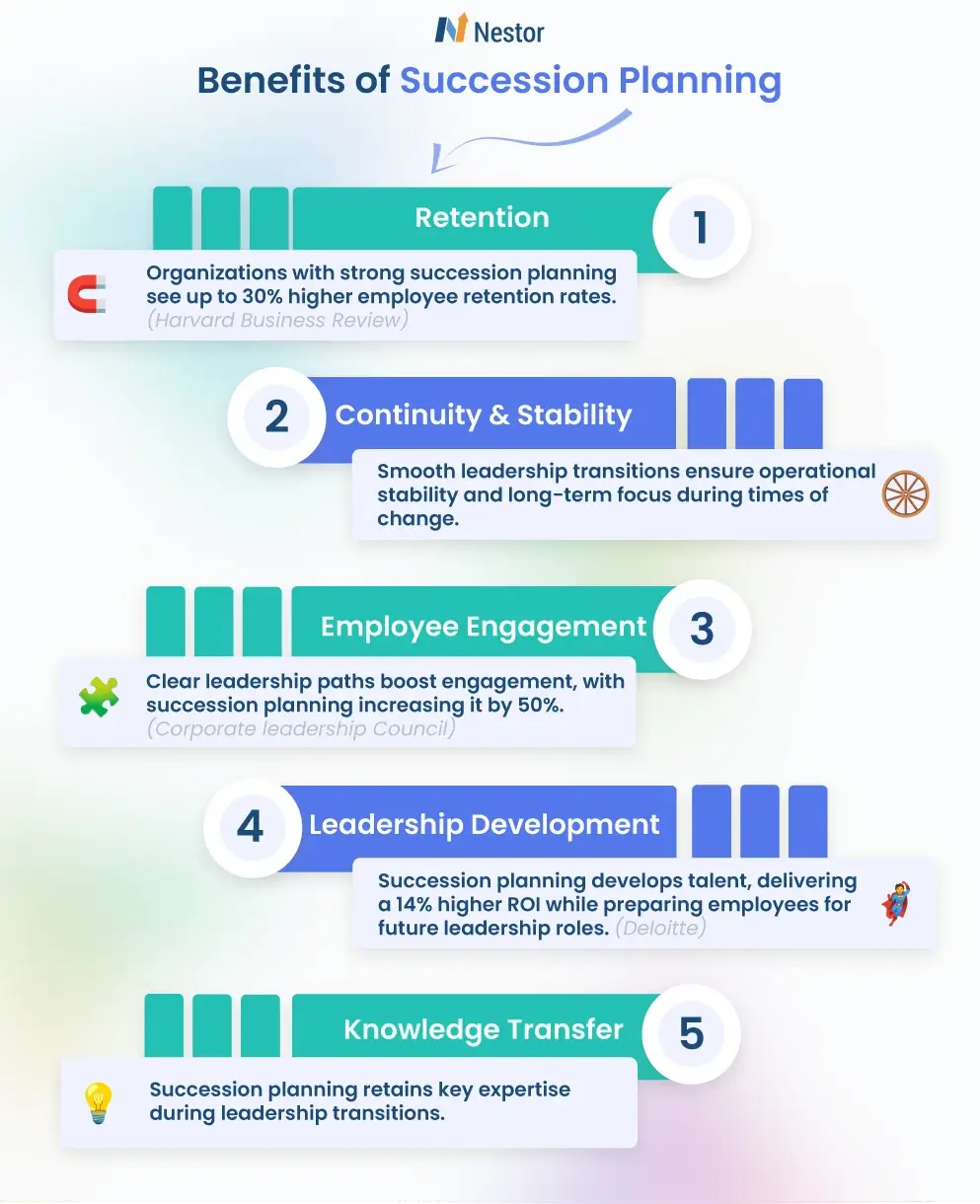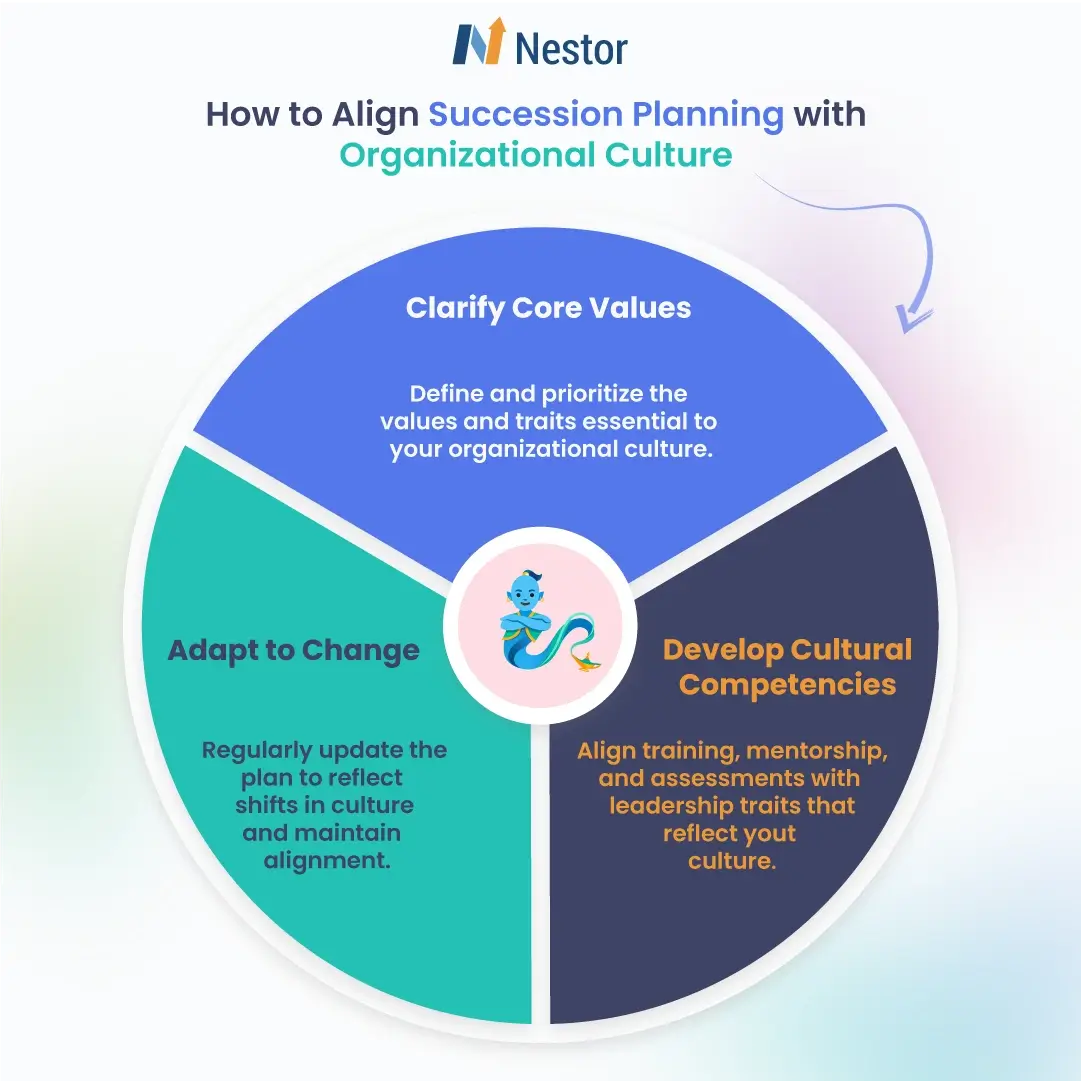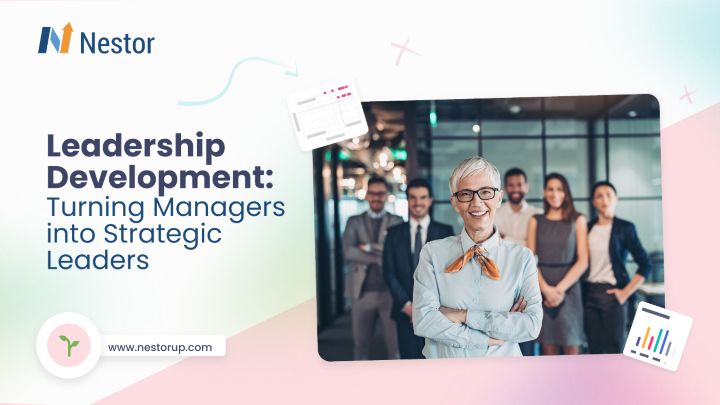
Contents
Succession planning is crucial for ensuring stability and continuity within an organization by preparing for future leadership needs. It’s not just about replacing leaders when they retire; it’s about proactively positioning the right talent for long-term success.
Succession planning plays a pivotal role in an organization’s long-term health. It’s not something that only large corporations need to worry about. Even small businesses must think about who will lead the team when key people leave. This process helps businesses avoid disruptions, maintain stability, and ensure smooth transitions when critical positions are vacated.
But why is it that so many organizations delay or neglect this process until the need becomes urgent? Is it a lack of awareness, or do they just think they’re immune to such challenges?
Perhaps it’s because succession planning feels like a distant priority – until it’s not. So, if you’re still not sure about whether your organization needs a succession plan, ask yourself: Can you afford the chaos of a key role being suddenly vacant with no plan in place?
The Evolution of Succession Planning
Succession planning has shifted significantly over time. In earlier years, companies would often only think about succession when faced with an unexpected departure or retirement of a key leader. This approach led to rushed decisions, with little attention given to preparing internal talent for future leadership roles.
Your employees’ success is directly tied to the resources, training, and development opportunities you provide. By investing in their growth, you’re not only improving their skills, but also demonstrating a strong commitment to their long-term success. As a result, this not only helps retain top talent, but also fosters a culture of continuous improvement.
Historical Context
- In the past, companies often viewed succession planning as a reactive measure to address sudden leadership changes or departures.
- Companies often hired externally for leadership roles, skipping the long-term development of internal talent.
- The approach was reactive rather than proactive, often leaving companies scrambling to find replacements.
Modern Shifts in Succession Planning
- Organizations now integrate succession planning into long-term strategies.
- Succession planning now spans beyond senior leadership, focusing on mid-level and emerging leaders across departments.
- Companies identify critical roles early and create development pathways to ensure leadership continuity.
- Succession plans are continuously updated and refined.
- Diversity and inclusion are integral parts of succession strategies, ensuring leadership teams are diverse and representative.
- Succession strategies are more transparent, with clear communication and involvement from employees
Why Succession Planning Matters Now More Than Ever
To really understand this part, let’s start with a well-known story in the tech world. One that involves a leadership scramble, a lot of uncertainty, and, surprisingly, a happy ending.
In 2013, Microsoft was blindsided when Steve Ballmer announced he’d be stepping down as CEO. Despite being one of the most profitable companies in the U.S., Microsoft seemed to have no solid plan for replacing him.
Rather than having a clear successor ready, the company launched an exhaustive search, considering over 100 candidates. After months of back-and-forth, they finally settled on Satya Nadella, who was already with the company.
While the process was messy, Nadella’s leadership quickly turned things around. He reshaped the company’s culture, pushed its cloud business, and saw Microsoft’s stock skyrocket by 30% in his first nine months. Back to the present, Microsoft’s stock skyrocket by more than 1,000% since Nadella took the helm in 2014.
The lesson here? Succession planning matters. A solid plan could have saved Microsoft a lot of time and drama. Leadership transitions don’t have to be so bumpy when you’re prepared in advance. So, let’s dive into the challenges companies are up against today and explore why succession planning has become more urgent than ever.
Workforce Challenges
Today’s workforce is facing challenges that make succession planning more urgent than ever. The aging workforce is a significant issue, with many senior leaders retiring in the near future, and there just aren’t enough qualified people ready to step in.
Alongside this, talent shortages are increasingly becoming a growing problem in many industries. Furthermore, to top it all off, high turnover rates are making it even harder for organizations to hold onto their best people, which ultimately adds more pressure to the succession planning process.
Additionally, depending on the complexity of the job, new hires often take 1-2 years to fully learn and excel in a role. This show the importance of having a strong succession plan in place well in advance.
If you don’t have a plan in place, you risk finding yourself in a situation where you’re scrambling to find a replacement when key players exit. This leaves a huge gap in knowledge and can disrupt day-to-day operations. This is particularly true in leadership roles, where institutional knowledge is vital to keep things running smoothly.
Organizational Risks
The risks of not having a succession plan are especially severe in the context of an aging workforce and ongoing talent shortages. As older workers retire or transition out of key roles, organizations face a significant gap in both leadership and specialized knowledge. This gap is particularly concerning in industries where seasoned expertise drives success.
With many senior leaders nearing retirement, there simply aren’t enough younger workers with the right skills and experience to take over. Consequently, the shortage of talent means that organizations may struggle to fill critical positions in a timely manner. As a result, this can lead to operational disruptions, delayed projects, and reduced productivity.
On top of that, the scarcity of skilled workers can drive up recruitment costs and make it even harder to find suitable replacements. If talent shortages persist, companies may resort to hiring less-qualified candidates, which can affect performance and customer satisfaction.
Strategic Advantage
On the flip side, an effective succession plan provides organizations with a strategic advantage by preparing the next generation of leaders. This ensures that the business can continue thriving even during leadership transitions.
A well-crafted succession plan not only aligns with the organization’s goals but also ensures that critical roles are always filled with the right people. As a result, this enables the business to continue growing, innovating, and adapting to change effectively.
Benefits of Succession Planning

When done right, succession planning has several key benefits:
- Retention: Employees see that the organization is committed to their growth, which leads to greater job satisfaction and retention. In fact, Harvard Business Review found that organizations with effective succession planning have 30% higher employee retention rates.
- Continuity & Stability: A smooth leadership transition ensures that the business remains stable and that operations continue without disruption. This helps the organization maintain focus on long-term goals while adapting to change.
- Employee Engagement: When employees feel like they have a path to leadership, they’re more engaged and motivated to work toward the company’s long-term success. In fact, a study by the Corporate Leadership Council found that organizations with succession plans are 50% more likely to have higher employee engagement levels, leading to increased productivity and overall performance.
- Leadership Development: Succession planning also acts as a powerful tool for developing talent. Employees are given the training, mentorship, and experiences they need to grow into leadership roles. A report by Deloitte found that organizations with effective succession planning see a 14% higher return on investment than those with poor succession planning practices. This highlights not only the value of preparing future leaders but also the tangible benefits it brings to the organization’s overall performance and growth.
Steps to Implement Succession Planning in Your Organization
Step 1: Assess Organizational Needs
The first step in implementing a succession plan is understanding where the organization is headed and how succession planning fits into that vision.
What are the long-term goals of your business? Where do you see the company in the next five to ten years? Aligning succession planning with your business goals ensures that you’re developing leaders who will help the company achieve these objectives.
Step 2: Define Key Positions and Roles
Next, you need to define which positions are crucial to your organization’s success. This could include leadership roles, but also consider other positions where talent gaps may arise. By identifying these roles early, you can begin the process of finding and preparing successors.
Step 3: Identify Potential Successors
Once you know what positions need to be filled, you can begin identifying potential successors. This doesn’t just mean choosing people who are already in senior roles; it may involve identifying promising middle managers, employees with leadership potential, or individuals with the right skills and attitudes to grow into key roles.
In fact, Cady O’Grady, Director of Human Resources at Greensfelder believes in having a succession plan for every role:
If an organization is communicating that only senior leadership positions have succession plans, it sends the wrong message that some people are valued more than others.
— Cady O’Grady
Step 4: Assess, Develop, and Prepare Successors
Once you have identified potential successors, it’s time to assess their readiness and outline their development needs. Determine whether they’re ready to step into the role immediately or if they need further training and experience.
Create individualized development plans for each successor, focusing on the skills, experiences, and knowledge they need to gain. This may include training programs, special projects, leadership development, and mentorship opportunities. By providing clear developmental pathways, you ensure that employees are equipped with the tools and experiences necessary to take on greater responsibilities in the future.
Step 5: Document and Communicate the Plan
Succession planning shouldn’t happen behind closed doors. Clearly document and communicate the entire plan to all stakeholders. This transparency ensures that everyone understands the process and buys into the plan. It also helps ensure that potential successors understand their path forward.
Step 6: Monitor Progress
Regularly monitor successor progress once the plan is active. Are they gaining the skills and experience they need? Are there any changes to the business that require adjustments to the succession plan? Regular check-ins and updates ensure that the plan stays relevant and effective.
Step 7: Regularly Review and Update the Plan
Succession planning isn’t a one-time event; it’s an ongoing process. Review and update the plan regularly to keep it aligned with the organization’s needs and goals. Leadership needs change over time, and succession planning must adapt to these changes.
Common Pitfalls to Avoid in Succession Planning
Lack of Transparency and Stakeholder Engagement
Succession planning is often viewed as an internal process, but transparency is key. Without clear communication, employees may feel excluded or uncertain about their future. Involving key stakeholders and gathering feedback from various teams helps build trust, ensures alignment on leadership qualities, and encourages buy-in from current employees.
Overlooking Diversity and Inclusion
One of the biggest risks in succession planning is overlooking diversity. Succession plans should be designed to be inclusive, ensuring that people of all backgrounds have the opportunity to rise to leadership positions. Leadership diversity strengthens the organization with varied perspectives and ideas.
A Fast Company report highlights that companies with above-average gender diversity and employee engagement levels outperform other companies by 46% to 58%. This statistic shows the importance of fostering diversity in leadership roles, as it directly contributes to better business outcomes.
Focusing Only on Senior Leaders
While succession planning is often associated with senior leadership positions, it’s important to plan for mid-level leaders and emerging talent as well. Developing a robust pipeline of leaders at all levels helps ensure that your organization is well-positioned for the future.
Neglecting External Candidates
Internal promotions are ideal, but there are times when external candidates bring fresh ideas and expertise that the organization needs. Expanding the talent pool to include external candidates can help you find the right person for the role, even if they’re not currently part of your company.
Tools and Technologies to Support Succession Planning
HR Analytics and Talent Management Software
Technology plays a vital role in streamlining succession planning. Tools like HR analytics and talent management software help organizations track employee performance, map talent, and assess readiness. These systems make it easier to identify potential leaders and ensure that succession plans are backed by data-driven insights.
Among these tools, Nestor stands out as a robust platform designed to assist HR teams. With Nestor’s data-rich dashboards, HR professionals can monitor employee progress, evaluate readiness, and align development plans with future organizational needs.
Nestor: A Comprehensive Solution for Succession Planning
Nestor is a powerful talent management and coaching platform that helps organizations cultivate future leaders by aligning employee development with business goals. Using AI-driven insights, Nestor supports HR leaders in tracking skills, guiding career growth, and identifying potential successors.
Here’s how Nestor can enhance succession planning efforts:
- Data-Driven Succession Planning Nestor’s platform provides insights into employee skills, engagement, and performance, allowing HR teams to make data-backed decisions about potential successors. By understanding employee strengths, skill gaps, and leadership potential, organizations can create a more targeted and effective succession plan.
- Skills Library and Gap Analysis Nestor’s extensive skills library—spanning over 20,000 skills across multiple industries—enables HR teams to map out the skills needed for leadership roles. Through skill gap analysis, Nestor identifies areas where employees need development, ensuring succession candidates are well-prepared for future leadership.
- Personalized Learning Paths for Leadership Development Nestor suggests tailored learning plans based on skill gaps and development needs, helping future leaders build competencies essential for succession. This feature ensures that employees are equipped with the right skills as they advance into leadership roles, aligning their growth with company objectives.
- AI-Powered Talent and Opportunity Marketplace Nestor’s internal talent marketplace matches employees with relevant projects, roles, or gigs, providing real-world opportunities for leadership candidates to demonstrate and hone their skills. This reduces external hiring costs and promotes engagement, allowing potential leaders to develop within the organization.
- Performance and Engagement Tools With features like 360-degree feedback, pulse surveys, and engagement analytics, Nestor provides a holistic view of employee readiness and motivation. These tools are essential for assessing not only skills but also commitment and cultural alignment, helping to ensure that succession candidates are both capable and engaged.
- Predictive Analytics for Proactive Succession Planning Nestor’s AI capabilities predict talent trends and identify emerging skills, helping HR teams stay ahead of leadership needs. This proactive approach helps organizations plan for leadership transitions by continuously assessing and preparing internal talent pools.
AI and Predictive Analytics
AI is revolutionizing succession planning by helping businesses predict future leadership needs. Predictive models can analyze employee performance, forecast turnover, and identify talent gaps before they become a problem. Here are some ways AI enhances succession planning:
- AI-Driven Talent Analytics: AI-driven analytics offers a precise view of employee strengths, areas for development, and potential for leadership roles. Moreover, AI-powered talent analytics assesses skills, competencies, and performance trends. As a result, this helps organizations pinpoint high-potential employees and evaluate their readiness for leadership. Furthermore, this approach brings accuracy and efficiency to succession planning by reducing guesswork and basing decisions on concrete data.
- Virtual Reality (VR) Leadership Training: VR technology, integrated with AI insights, provides immersive, hands-on leadership training that simulates real-life scenarios. Potential leaders can develop decision-making and problem-solving skills in a controlled environment. This allows them to build confidence and gain experience. VR also enables training in complex interpersonal skills. Skills such as conflict resolution and team management are essential for effective leadership.
- Predictive Models for Talent Retention: Predictive models powered by AI assess trends in engagement, satisfaction, and career progression. As a result, this helps HR teams forecast potential turnover among top talent. Moreover, by identifying employees at risk of leaving, these models enable organizations to address concerns proactively. In addition, they help provide growth opportunities to retain high-potential individuals. Consequently, succession planning gains invaluable insights from this predictive capability. Ultimately, it allows HR teams to secure a stable talent pipeline by keeping key players on their leadership track.
These AI tools allow organizations to approach succession planning with a forward-looking perspective. This ensures a talent pool that is both well-prepared and engaged. With these resources, companies can better meet future leadership demands.
How to Align Succession Planning with Organizational Culture

Your succession plan should be tailored to fit the unique culture of your organization. Specifically, this means considering your company’s values, leadership style, and expectations. By aligning succession planning with culture, you can help ensure that future leaders will not only resonate with but also reinforce what your organization stands for. Ultimately, this alignment fosters continuity and strengthens your company’s long-term vision.
- Identify Core Values: Begin by clarifying the values your organization prioritizes. Are collaboration, innovation, or resilience essential to your culture? Make sure these qualities are reflected in your criteria for potential successors.
- Incorporate Cultural Competencies: Identify specific cultural traits essential for leaders in your organization. Integrate these into training programs, mentorship opportunities, and assessments to ensure your future leaders embody your organizational identity.
- Monitor and Adapt to Cultural Shifts: Organizational culture can evolve, so it’s important to regularly reassess your succession plan. Stay flexible and update the plan to reflect any cultural shifts, ensuring that future leaders continue to embody your organization’s core identity.
- Use Real-World Projects for Leadership Testing: Instead of relying solely on formal training, offer high-potential employees the chance to lead cross-functional projects or initiatives. This gives them practical experience in your company’s culture while showcasing their leadership potential.
Engaging employees in this process ensures a smoother transition and helps identify leaders who are both competent and culturally aligned, creating continuity as the organization grows.
Measuring the Success of Succession Planning
To determine if your succession plan is effective, it’s essential to track various metrics and gather feedback, which provides a clear view of both strengths and areas for improvement.
Quantitative Metrics
Use measurable indicators to track progress. Key metrics to consider include:
- Turnover Rates: High turnover among leaders could indicate a gap in preparation or alignment with expectations.
- Internal Promotions: Track how often internal employees are promoted to leadership roles. A high rate of internal promotions suggests effective talent development.
- Leadership Development Program Participation: Monitor how many potential leaders participate in development programs, as well as their growth and engagement.
Qualitative Feedback
Gain insights through structured feedback from employees and leaders.
- Employee Satisfaction Surveys: Regularly ask employees about their views on leadership development opportunities and alignment with company culture.
- Exit Interviews with Leaders: Conduct thorough exit interviews with leaders to gather insights on why they’re leaving and what could improve.
- Performance Reviews of New Leaders: Assess new leaders’ performance to identify strengths and any gaps in readiness or cultural fit.
By combining data with qualitative feedback, organizations can refine their succession plans, better preparing future leaders for sustained success.
Future Trends in Succession Planning
As work dynamics shift, succession planning must adapt to new demands, skills, and generational expectations. Here are key trends influencing the future of leadership planning:
Remote Work Adaptation
With more organizations adopting hybrid and remote work models, it is crucial that leaders excel in virtual communication and remote team management. Therefore, succession plans should focus on candidates who can not only adapt but also lead effectively across distances. Consequently, this ensures seamless leadership transition in a rapidly evolving work environment.
Recent research shows that exclusively remote employees tend to report higher employee engagement than those working on-site; 37% of remote workers feel engaged, compared to just 30% of on-site workers. This highlights the importance of identifying leaders who can foster engagement and connection in remote or hybrid settings.
Global Talent Pools
Increasingly, organizations are broadening their search for leaders, considering talent from around the world. According to the Decoding Global Talent 2024 study, 1 in 4 (23%) employees are actively seeking jobs in other countries, while 63% express a general openness to the idea. This shift demands that potential leaders demonstrate cross-cultural competence and adaptability.
Emphasis on Emotional Intelligence (EQ)
With the rise in remote and virtual work, leaders need strong interpersonal skills. High EQ will be a core requirement in succession planning, as leaders must engage and motivate teams with empathy.
In fact, the demand for EQ skills is likely to grow by 6x in the next 3-5 years. As such, organizations must prioritize EQ development in their leadership pipeline to ensure leaders can effectively navigate team dynamics.
Generational Shifts
As Gen Z enters the workforce, their values will influence leadership styles and expectations. Currently, Gen Z makes up 30% of the world’s population and is expected to account for 27% of the global workforce by 2025.
This generation often values transparency, purpose-driven work, and work-life balance, so succession planning must align with these values to attract and retain emerging leaders.
Focus on Soft Skills and Flexibility
Leaders today need a blend of hard skills and flexibility to navigate rapid changes. Succession planning should emphasize adaptability, communication skills, and resilience over more traditional leadership qualities.
A previous LinkedIn report shows that that 92% of companies believe human capabilities, or soft skills, matter as much or more than hard skills in today’s business environment.
By anticipating these trends and adjusting succession planning criteria, organizations can ensure their future leaders are ready to thrive in a rapidly evolving work environment.
Example of succession planning
Let’s also have a quick look at a made-up example of a succession plan:
Key roles
- Founder and CEO: John
- Chief Operating Officer (COO): Sarah
- Vice President of Sales: Michael
Key steps in the succession plan
1. Identifying succession needs
John and the board of directors recognize the need for a succession plan to ensure a smooth leadership transition when he retires.
The board appoints a Succession Planning Committee with senior executives, board members, and HR staff
2. Identifying potential successors
The Succession Planning Committee conducts a thorough assessment of internal candidates to identify potential successors.
After considering various factors like leadership skills, industry knowledge, and experience, they shortlist two strong candidates: Sarah and Michael.
3. Leadership development and mentoring
The committee informs Sarah and Michael about their selection as potential successors.
John personally mentors both candidates and provides them with exposure to different aspects of the business, including strategic decision-making, financial management, and team leadership.
They are encouraged to attend leadership development programs and participate in executive education to enhance their skills.
4. Transition and Formal Succession
As retirement approaches, John begins gradually transferring responsibilities to Sarah and Michael. They work closely with him to understand the company’s vision, goals, and values, ensuring a smooth transition of leadership. John creates opportunities for them to lead important initiatives, allowing them to gain hands-on experience in their new roles.
Based on evaluations and overall performance during the test phase, the board officially appoints Sarah as the new CEO. Michael is promoted to COO, stepping into Sarah’s previous role. The board then formally announces the transition to employees and stakeholders.
5. Evaluation and Support
The board starts with a test phase where Sarah and Michael temporarily take on the CEO and COO roles. This gives the board a chance to assess their ability to manage the challenges of the position.
Regular evaluations take place to track their performance, gather feedback, and identify areas for improvement.
As Sarah and Michael settle into their roles, they are encouraged to create succession plans and mentor potential future leaders within the company.
Final Thoughts: Building a Robust Succession Plan for the Future
Investing in a solid succession plan today ensures your company’s future success. Whether you’re a large corporation or a small business, you can’t afford to wait until the last minute to create a plan.
If you haven’t started your succession planning efforts yet, now is the time to act. The longer you wait, the more you risk leaving your organization vulnerable to leadership gaps and disruptions.
Start today. Make succession planning a priority. Your company’s future depends on it.
Frequently Asked Questions (FAQ) About Succession Planning
What is succession planning?
Succession planning is the process of identifying and developing future leaders within an organization to ensure a smooth leadership transition when key roles become vacant.
Why is succession planning important?
Succession planning ensures continuity in leadership, reduces disruption, and helps organizations retain top talent, fostering growth and stability.
What steps should organizations take to implement succession planning?
Organizations should assess current leadership needs, identify high-potential employees, provide development opportunities, and create a clear roadmap for leadership transitions.
What tools and technologies can support succession planning?
Tools like HR analytics, talent management software, AI-driven analytics, and platforms like Nestor can help track performance, assess skills, and predict future leadership needs.
Nestor is a talent management and coaching platform that aligns employee development with business goals. By utilizing AI-driven insights, Nestor supports HR teams in tracking employee skills, guiding career growth, and identifying potential successors.
How do organizations identify high-potential employees for succession planning?
By evaluating employee performance, skills, potential for growth, and alignment with company culture, often using data from performance reviews and leadership assessments.
How often should a succession plan be reviewed and updated?
Succession plans should be reviewed at least annually or whenever significant changes in leadership or business strategy occur.








